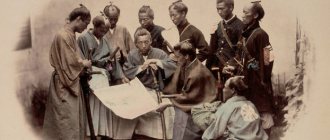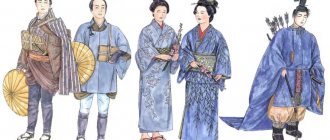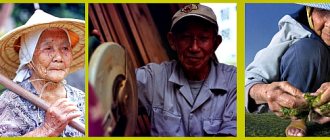Research conducted at battle sites in Japan shows that 30% of the remains of warriors found belong to women. Who are these women who fought side by side with men and died like true warriors?
Onna-bugeisha (the term consists of the words: onna (女) - “woman” and bugeisha (武芸者) - “person of martial arts"). Sometimes not very knowledgeable people call them “women samurai,” but to say so is not entirely correct, since the word “samurai” is used only in relation to men. Onna-bugeisha, like samurai, put the bushido code above all else, the interests of others above their own, the concept of honor was in the first place for them, and if necessary, they gave up their lives without a shadow of a doubt, performing the jigai ritual.
buke-no-onna may also be applied to women of the samurai class , meaning “woman of the buke (bushi) class,” but unlike “onna-bugeisha,” it does not mean that the woman actually participated in battles on an equal basis with men, but only speaks of her origin and, perhaps, that she received the minimum knowledge in hand-to-hand fighting and fencing, traditional for a woman of the samurai class.
What is known about onna-bugeisha
First of all, it should be mentioned that the term “samurai” was not used in relation to representatives of the fairer sex. Only men had the right to be called samurai. This word contains two hieroglyphs: “to serve” and “warrior”. Onna-bugeisha means "man of martial arts" in Japanese. This was the name given to ladies who belonged to the samurai class and learned to handle various types of weapons.
Onna-bugeisha is a woman who not only wields weapons, but also participates in battles on an equal basis with the stronger sex. Also, such a lady can take revenge on the enemies who killed the master and insulted him. It is known that it was the fair sex in Japan who were famous for their devotion, often surpassing men in this.
Famous representatives
The above tells us that a female samurai is not a beautiful legend at all. Which warriors who belonged to the samurai class managed to leave a mark on history? First of all, we should remember a lady named Hangaku Gozen, who lived at the end of the Heian era, which lasted from 794 to 1185. This fearless woman took part in the battle with the 10,000-strong army of the Hojo clan, who fought on the side of Shogun Minamoto. There were 3 thousand soldiers under her command. The battle was lost, but Hangaku, who was wounded, managed to survive. She subsequently got married and had a child.
Hojo Masako is another famous female samurai who was born in 1156 in Japan. After the death of Shogun Minamoto no Yerimoto, who was her husband, this fearless lady actually took over the management of the lands that belonged to him, his sons were only called rulers. It is also known that she bore the nickname “Shogun Nun” and ensured the power of the Hojo clan.
Of course, there were other prominent female samurai in Japan. For example, one cannot help but recall Nakano Takeko, born in 1847. This brave warrior was among those who defended the Aizu Palace after the Tokugawa Shogunate fell. Unfortunately, she died in this battle, but her memory remains.
The Art of Death or Samurai Women
The female samurai, or “onna-bugeisha,” in medieval Japan was an almost mythological character, and, according to many contemporaries, non-existent. The fact is that only a few girls in samurai families took up arms. The fair sex was supposed to be charmingly helpless, feminine and graceful. Japanese culture demanded this. Possession of a spear and dagger did not fit into the traditional concept. The girl obeyed her father, the woman obeyed her husband, and if he died, then the eldest son became the head of the family. In a Japanese family, the wife got up early in the morning and did housework until late at night. She watched the house when the samurai went on another campaign. If a girl was allowed to train in martial arts, it was the exception rather than the rule.
This is indirectly evidenced by the fact that homosexuality was widespread among the samurai - “shudo” (“the way of the youth”). Japanese morality did not prohibit relationships between two men. This kind of connection was contrasted with the “softening” female love. In fiction, “shudo” was depicted as a necessary stage in a young man’s growing up. There was an opinion that such relationships enrich the young man with knowledge.
If a samurai family nevertheless decided to raise a warrior girl, they did so without making allowances for the weaker sex. She was kept in strictness, like her brothers. To cultivate fearlessness, a girl could be sent to the forest or to a cemetery at night.
The samurai culture provided not only for the improvement of physical abilities, but also for a comprehensive education. Young warriors were introduced to poetry, taught drawing, playing musical instruments and the art of calligraphy. A special place was given to folklore; children were told about the amazing exploits of samurai. A popular story was about the girl Tokoye, who restored honor to her father. The main characters of theatrical productions were famous military leaders. Central to these productions were the ideas of absolute loyalty and revenge. “Onna-bugeisha” studied the samurai’s code of honor - “The Way of the Bow and the Horse” (later Bushido). Warriors were prepared for death. “Not achieving your goal and continuing to live is cowardice,” the children were instructed.
To develop endurance in girls, they were forced to do hard physical work from early morning until late evening and were kept on a diet. It was believed that a samurai should be content with a small amount of food. Girls were taught to use weapons, primarily the kaiken dagger. They were comfortable striking in close combat. It was hidden in a sleeve or behind a belt, sometimes placed in a small bag. The length of the blade was about 6 centimeters. The kaiken has also been used as a suicide weapon.
[region:bone:inline_1]
The girls also owned a naginata - a curved blade with a long handle. These weapons were usually kept at the entrance to the house. The length of the naginata handle ranged from 1.2 to 2 meters; blade - about 30 centimeters. Over time, a lightweight version of this weapon gained great popularity. The naginata was especially effective against cavalry, giving it an advantage over distance.
According to legend, the female warrior Hojo Masako was excellent at wielding this weapon. She was born into the family of a large feudal lord in 1156. Times were turbulent, and Masako was raised by her father as a samurai. The girl went hunting with men and improved her fighting skills every day. In surviving sources, Hojo is described as a warrior of exceptional bravery. Her fiancé was the founder of the Kamakura shogunate. The ruler waged continuous wars, and after the death of his wife, Hojo took over the management of his lands. She succeeded in transferring the title of shikken (regent) to her nephew.
The naginata remained a classic “female” weapon for several centuries. In the 17th century, every member of the nobility was taught to use it for self-defense; later this knowledge was passed on to girls in schools. The corresponding program in schools was in effect until 1945.
Female samurai also knew how to use the yari spear, which was 2 to 4 meters long. The shaft was usually made of oak. Its upper part was wrapped with a strong cord. Brushes of different colors were attached to the spear, which indicated the position of the warrior. The lower part of the shaft was usually polished for the convenience of the samurai. Yari was richly decorated. The spear had many varieties depending on the length of the blade and the shape of the tip.
One of the most famous warriors in Japanese folklore was Tomoe Gozen. The girl was not only a beauty, but also an experienced archer. She was born in 1157, and in 1180 a civil war began in the country. According to one version, Gozen died on the battlefield along with her husband. According to another, the surviving warriors ordered her to flee, since dying next to a woman was contrary to the samurai code. The third version tells that Gozen became a nun. Another famous “onna-bugeisha” is Edogimi. She committed suicide after being defeated in battle.
Over time, women stopped fighting alongside male warriors. With the cessation of civil strife, the princes did not need large detachments of samurai. This concerned girls primarily; their participation was required at home, in a large household. The last in the line of famous warriors was Nakano Takeko. She was born around 1847 into the family of an influential official. It is known that Nakano received a good education. A capable girl became a martial arts instructor. In 1868, the “War of the Year of the Dragon” began, and Nakano offered her services to the samurai. Her unit was banned from fighting as an official army unit. Despite the ban, the girl took part in the fighting. During one of the battles, the “Women's Detachment” was defeated by the imperial troops. Nakano was seriously wounded and asked her sister to kill her and bury her so that the body would not fall to the enemy.
Based on materials
What is known about buke-no-onna
Of course, ladies who fought equally with the stronger sex were still the exception rather than the rule. Much more often one could find buke-no-onna. Such women were not required to participate in battles. They acquired fencing and hand-to-hand fighting skills primarily in order to protect their family, if necessary, and to teach children.
It was believed that the buke-no-onna should obey her husband and serve him impeccably. They should also be devoid of weaknesses typical of the fair sex, and demonstrate fortitude in all situations. Such ladies also had the right to revenge if someone killed members of their family or caused a serious insult.
Weapon
What weapons did the average female samurai know how to use? For example, it was a naginata - a traditional Japanese edged weapon, the name of which translates as “long sword”. She was also required to skillfully wield the tanto - the name of the samurai dagger, the name of which, translated from Japanese, means “short sword.” The warriors also fought with ropes and chains, and yari spears.
Traditions told us to keep the spear in a special place, which was located above the front door. This ensured that the woman would have time to grab it to protect herself and her children in the event of a sudden attack by the enemy or the appearance of uninvited guests. Ladies also used a short dagger called a kaiken. Japanese women practically never parted with this weapon; they wore it in their belts or in their sleeves. The dagger made it possible to quickly wound or kill an enemy in close combat, and it was also thrown with amazing speed. It is known that the warrior girl received a knife on the day she reached adulthood. This happened when she was 12 years old.
Weapons of a female samurai: “dolls” from a naginata
Regular members of the samurai class were not expected to participate in battles, but women were nonetheless expected to be able to defend themselves and their homes and train their children. According to Bushido, the first duty of a samurai woman was to serve her husband. The Bushido Code also praised women “who were capable of rising above the imperfections and defects inherent in their sex, and of displaying a heroic fortitude that would have been worthy of the bravest and noblest of men.”
Among weapons, women were taught to use mainly naginata (the art of naginatajutsu). This weapon - a curved blade with a long handle - was usually kept at the entrance to the house. The length of the naginata handle ranged from 1.2 to 2 meters; blade - about 30 centimeters. Over time, a lightweight version of this weapon gained great popularity. The naginata was especially effective against cavalry, giving it an advantage over distance. Women knew how to handle a yari spear (2 to 4 meters long), chains and ropes. Instead of a katana, they had a tanto. The usual place for storing a spear was above the door to the home, since in this way the woman was able to use it against attacking enemies or any uninvited guest who entered the house. Women also knew how to handle a short dagger (kaiken) with no less skill, which, like the wakizashi of male warriors, was always with her - in her sleeve or in her belt. The Kaiken can deliver both lightning-fast melee strikes and can be thrown with deadly speed. The length of the blade was about 6 centimeters. The knife was given on the day the girl reached adulthood (at 12 years old) according to the ritual.
Also, kaiken was necessary in committing ritual suicide (the female version of this action is called jigai and was as widespread as seppuku among men). Moreover, women did not rip open their bellies like men, but cut their own throats. Another strict rule of the ritual was the obligatory tying of one’s own ankles in order to look decent even after death. When there was a real threat of being captured by the enemy, they not only resolutely accepted death at the hands of male relatives or their commanders, but also killed the men themselves if for some reason they were unable or unwilling to perform the ritual act and did not spare such a situation, neither yourself nor your children.
When necessary, samurai women took upon themselves the responsibility of carrying out revenge, which was considered the only possible reaction (according to the Japanese interpretation of Confucianism) to insulting or killing a master. Even during the stagnant period of the Tokugawa shogunate, women strictly observed the principle of unconditional loyalty to their clan - sometimes even stricter than men.
So, many girls from the samurai class have mastered serious martial arts since childhood: wielding a naginata halberd, throwing knives and darts, archery, and jujutsu techniques. So samurai women, who outwardly seemed like harmless creatures, could, if necessary, fight back a rapist or an enemy who attacked her home. “Unexpectedly for the attacker, the “doll” packed in a kimono suddenly took a fighting stance, the graceful pins from her hair turned into throwing knives, the fan bristled with steel needles. and in a small graceful hand a sparkling dagger appeared from nowhere. Well, if she managed to arm herself with a naginata, then dealing with her was more dangerous than with an angry tigress.”
Suicide
Did Japanese women commit ritual suicide, as was customary among male samurai? Yes, this ritual was called jigai and was widespread. Ladies did not commit suicide the same way as the stronger sex did. They did not rip open their bellies, preferring to cut their own throats.
The ritual had to be carried out in accordance with all the rules. One of them orders that women who decide to die must first tie their ankles. This was done in order to have a decent appearance after death. Most often, Japanese women decided to commit suicide when there was a threat of ending up in the hands of the enemy. Moreover, they often killed not only themselves, but also their less brave relatives, including their own children.
A crisis
The female samurai is a common sight in the 11th to 17th centuries. At the beginning of the 13th century, laws were approved according to which representatives of the weaker sex had the same rights to their paternal inheritance as their brothers. Ladies were also allowed to leave a will and dispose of their property.
The crisis came in the 17th century, when attitudes towards female warriors deteriorated significantly. Some historians attribute this to the widespread fashion for same-sex relationships in the samurai ranks. However, the brave warriors continued to amaze the world with their exploits, refusing to be used as pawns in the matrimonial market.
For example, many ladies participated in the Boshin Civil War, which took place in the 19th century. Some of them even went down in history.
Woman in the Japanese Middle Ages (VIII-XVI centuries)
Much is known about medieval Japan (8th-16th centuries): first, the aristocracy ruled, which left behind masterpieces of world literature, then the military class - the samurai - came to power. The religions of Buddhism and Shinto, as well as Confucian teachings, played a key role in the life of the Japanese at that time. Read what role the Japanese woman played in all this.
Woman in Japan of the early Middle Ages (VII-XII centuries)
In ancient Japan, a woman's role in the family hierarchy was not very different from a man's. Examples include a number of regent empresses who ruled until a male heir was born or matured. This practice came to an end in the 8th century. Some researchers believe that before the arrival of Chinese culture, matriarchy was at first in force in Japan, which was gradually replaced by the cult of the leader and the establishment of the husband at the head of the family.
Sculpture of Himiko in a museum in Osaka
The very first mention of Japan in Chinese chronicles - they date back to the 3rd century - indicates that one of the local states is ruled by a woman named Himiko. We should also not forget that the sun goddess Amaterasu, from whom, according to legend, the imperial family descends, is a woman.
In the 6th-8th centuries, the Japanese elite actively borrowed Chinese culture, and with it came religion. Buddhist teachings took root well in Japan and brought with them a radical view of women: according to Buddhist teachings, they could not achieve enlightenment. The Flower Garland Sutra said: “Women are the messengers of hell who can destroy the seeds of the Buddha.” Women were also forbidden to set foot on certain sacred grounds, a prohibition (nyonin kekkai) that continues to this day. His manifesto is still served by special stones with ancient inscriptions, which strictly prohibit women from walking on the sacred ground, since female ritual impurity can stain it.
Girl at the ritual gate prohibiting women from going further
The Heian era begins (794–1185). For three centuries in a row, the influential Fujiwara clan was in power: Fujiwara girls were married off to the emperors, which gave legitimacy to their rule.
Heian is, first and foremost, an era of stability: the sophistication of the metropolitan elite culture that developed during this period is striking even today. At this time, many of the greatest works of literature were written: stories, notes and diaries came out from under the brush of the court nobility. Many of them were written by talented women.
Despite the subordinate position of women in Buddhism, aristocrats in Heian have fairly broad rights and are well educated, and some of them have a peculiar attitude towards religion:
“The preacher must have a handsome face. When you look at him without taking your eyes off, you better comprehend the holiness of the teaching. And if you look around, your thoughts will involuntarily run away. An ugly teacher, I think, leads us into sin,” writes Sei Shonagon in “Notes at the Bedside.”
The life of a noble woman is well known from the “literature of the female stream”: the mentioned poetess Sei Shonagon, as well as Mititsuna no Haha, Murasaki Shikibu and other great writers describe in detail their lives, personal experiences and the way of Heian society.
Murasaki Shikibu writes that life at court is the life of people “having leisure,” a series of romantic adventures, sad and joyful moments. Class affiliation completely determined a person’s position in Heian society. Much of a woman's life can be learned from her role in a relationship with a man.
For example, an aristocrat could respond to a gentleman’s love letter that she knows about the man’s frivolity, which is why she refuses to enter into a relationship with him. It was also considered the norm that for some time after marriage the husband lived in his wife’s house in order to strengthen the union of the two families. The lady even had the right to divorce if there were good reasons for this, and when dividing the property she received her share.
Little is known about the life of ordinary Japanese workers and their wives in the Middle Ages: commoners, alas, did not know how to write, and the upper class were not interested in their affairs.
While the palace ladies and gentlemen practiced poetry and were absorbed in the passions of love, life in the rest of Japan did not change for centuries: peasants worked in the fields all day, lived in small huts and knew neither about emperors nor about the great literature that was written at that time in Heian-kyo, modern Kyoto.
Woman in samurai Japan
Kamakura (1185–1333)
At the beginning of the Kamakura era, women from the aristocracy and the samurai class were treated the same as in the Heian period: they received an education, were interested in the arts, were quite free in marriage, had rights to real estate, be it a plot of land or a house - in the end , even though the samurai came to power, the aristocracy and its traditions have not gone away. And yet, serious upheavals, constant internecine wars, the collapse of the state into many inheritances of individual feudal daimyos, and the influence of Confucian patriarchal teachings greatly change gender relations. By the end of the “Era of the Warring Provinces” (16th century), a woman becomes completely dependent on a man.
Image of a female samurai
In early Kamakura, the Buddhist monk Nichiren rethinks the role of women: he consistently explains to his contemporaries that a woman can still achieve enlightenment. Such a teaching, for obvious reasons, was popular among nuns and religious women: the monk’s correspondence with his admirers has been preserved, in which he advises them on a variety of topics.
Statue of Nichiren at Honnouji Temple
Of course, Nichiren’s teaching did not go beyond the boundaries familiar to medieval society: the monk perceived a woman only in the traditional role of wife and mother. In one of his letters, Nichiren gives advice to a single mother who, for unknown reasons, lost her husband:
“Women treat their husbands as their own souls. Without their husbands, in the place of their souls there is emptiness. However, nowadays even married women cannot find a place for themselves in this world. Even though you have lost your soul (your husband), you live in a way that many married women do not live. Even more: since you maintain faith in the gods and revere Buddha, you are truly superior to others.”
Daughters and sons initially have equal chances of inheriting. An interesting case is documented when a father bequeathed all his property to a child who was in the womb of his daughter Nagaharume. The gender of the child was not important. Parents could give a significant part of the inheritance to their favorite daughter (chakushi): brothers and sisters received their share, but in a smaller amount.
Speaking of married life: the idea of marriage in the Middle Ages was different from the modern one. The bride and groom did not apply to the local registry office to consolidate the union, and the main collection of laws of Joei Shikimoku did not clearly define the term “marriage.” Polygamy was the norm: Japanese scholars suggest that it was considered acceptable for an aristocrat to have up to three wives, while a samurai could have only one wife and an unlimited harem of concubines (mekake).
Robes of the aristocracy of medieval Japan
Women were not given such freedom, and almost all Japanese women were monogamous. But after the death of her husband, the widow (goke) often received the inheritance of her late husband. This continued in Heian and during the first decades of samurai rule. Goke could rewrite the inheritance to one of the children or completely cancel the husband’s will if the heir or heiress did not show themselves in the best light.
The wives were also interested in economic matters: from a document of 1322, an interesting case is known when a man turned to the authorities with a complaint that his aunt, one of the wives of a certain Kawamura, “brought many workers to his fields so that they would take away his rice harvest.”
In the second half of Kamakura, the military government ( bakufu
) begins to impose restrictions on women's property rights. In 1232, the bakufu regulated the activities of widows: apparently, they often disposed of the property of their deceased spouses at their own discretion. In 1267, women who remarried were deprived of the right to their ex-husband's property. The Mongol invasion that shocked Japan at the end of the 13th century accelerated the introduction of restrictions. At this time, the bakufu formally abolished women's right to inherit property. By the Muromachi era (1336–1573), having lost the rights to inheritance and property, the woman gradually became completely subordinate to the head of the family.
Muromachi and Sengoku (1336–1573)
Around this period, the order of family life was finally established, which was firmly preserved until the 20th century: the wife now lived in the house of her husband’s parents, which bound the woman with ties of gratitude to those who sheltered her.
The wives of samurai had very limited rights and often became bargaining chips in political games: daimyos married off their daughters to neighboring feudal lords in order to strengthen their positions in the region. However, commoners at that time actively participated in trade: a large fan shop was run by the nun Genryo, there is evidence that at one time an office under the leadership of a woman, Kimura Goijyo, was engaged in salt mining, and her possible relative Kameyo Goijyo ran a workshop for sewing obi belts for kimono.
There are not many stories about female samurai in Japanese history: the most outstanding warriors are Tomoe Gozen and Hojo Masako. Often women stood up to defend their native castle from invaders.
Court aristocrats and their language
Details have been preserved about the lives of aristocratic women. Confucianism and Buddhism prescribed that an exemplary daughter-in-law should be taciturn: this is known from the behavior manuals that Japanese aristocrats themselves wrote for their daughters from the 12th to the 16th centuries. The poet Abutsu-ni writes to her daughter:
“Even when something good happens, don’t say that you are happy about it... Don’t be straightforward in matters concerning others, your personal life and what’s on your mind, and don’t show feelings. Keep everything in your head. It’s not good to speak thoughtlessly.”
Educated ladies knew Chinese characters, but did not write them, since such a right was attributed to men. The poetess writes:
“Women should not use Chinese writing. However, not knowing the hieroglyphs can be a problem, as they appear in the titles of some songs.”
The very existence of such manuals indirectly indicates that there were frivolous characters among women who did not follow the norms. In the 13th century manual “The Book of the Nurse” 乳母の草紙 we find a colorful description:
“Any pretty little mouth is ugly when it opens in laughter and the throat is exposed, when the tongue is visible and saliva flies from the corners of the mouth.”
A quote from the same book instructs the ladies of the court:
“Make sure that when your daughter turns 10, she lives in the back of the house, away from others. Raise her to be a girl who is intelligent and speaks in a quiet voice. Don’t let her do what she wants, say what she wants, and mess around on the terrace.”
Being isolated from the outside world, noble women in the palace began to communicate in a special argot (the language of a closed circle of people) - “the language of the court ladies” (palate: kotoba). Aristocrats replaced the names of the things that surrounded them in everyday life: the word was either completely changed, or the prefix “o” was added at the beginning of the word, and one or more syllables were dropped at the end and the suffix “moji” was added: “sushi” became “o-sushi”, the Portuguese "padre" became "pa-moji" and so on.
From the capital, the language eventually spread to the samurai castles: the humble servants in the castle had to learn this language, which they were extremely unhappy about. The language of the court ladies happily continued to exist during the Edo period (1603–1868). The townspeople ridiculed it as absurd and unnecessary, although Edo women's manuals hold up the courtly language as an example of the elegant speech that any respectable woman should possess.
Conclusion
The story of Japanese women in the Middle Ages is a tale of slow, centuries-long enslavement under the influence of circumstances and Chinese patriarchal culture. However, in Heian noble women were among the most educated people of the era, and under the rule of the samurai, their wives found themselves in raising children, managing household affairs and religion. Some devoted their lives to trade or even the art of war. The history of Japanese women, of course, does not end there - from the Edo era there are countless written monuments in which the lives of women are described by male writers like the legendary Ihara Saikaku. In Meiji and the first half of the 20th century, despite general Westernization, a woman remained, first and foremost, a wife and mother. However, this is a topic for another article!
Thank you for reading the article. A short excursion into Japanese history from the Arzamas project will help organize the knowledge gained. We recommend!
Sources:
M.V. Shabaeva “Diary prose as a historical source about the medieval society of Japan”;
Mallary A. Silva "Women in Ancient Japan: From Matriarchal Antiquity to Acquiescent Confinement";
Toshie Kurihara "A History of Women in Japanese Buddhism: Nichiren's Perspectives on the Enlightenment of Women";
Hitomi Tonomura "Women and Inheritance in Japan's Early Warrior Society";
Wakita Haruko and Suzanne Gay “Marriage and Property in Premodern Japan from the Perspective of Women's History”;
Momoko Nakamura “Gender, Language and Ideology: A genealogy of Japanese women's language”











